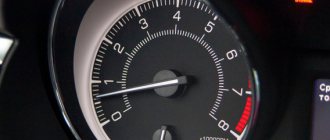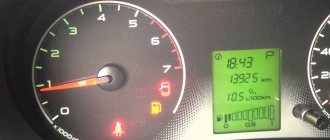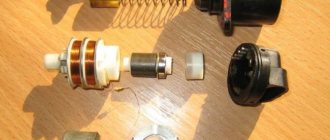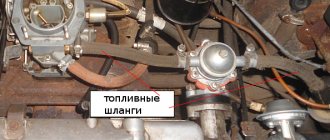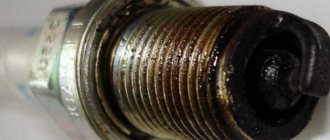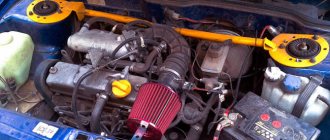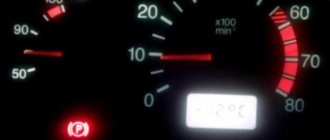Car : VAZ 2112. Asking : Belkin Ivan. The essence of the question : VAZ-2112 stalls at idle, what should I do?
Hello! I have the same problem starting the engine on a VAZ-2112. At one time it takes a long time to start, but then it starts with difficulty, and at another time it may start the first time and immediately stall. What could be the reason for this behavior? There is no difference whether it starts when it is cold or when it is hot.
missing idle on 2112
If there is no idle speed at all, but the car starts but stalls as soon as you release the gas pedal, then 99% that it is the idle speed valve (that’s what it’s called) located on the bottom side of the throttle body.
Unscrew it (it is secured with two screws) and turn on the ignition without starting, the valve should work back and forth and stand up. If he doesn’t move, then he’s on his way to the trash heap. If there is no idle speed at all, but the car starts but stalls as soon as you release the gas pedal, then 99% that it is the idle speed valve (that’s what it’s called) located on the bottom side of the throttle body. Unscrew it (it is secured with two screws) and turn on the ignition without starting, the valve should work back and forth and stand up. If he doesn’t move, then he’s on his way to the trash heap.
Service centers and service stations, for whom were they made?
to improve your well-being
I read your posts at idle and am dazzled. Everyone has known about these problems for a long time and there is no point in discussing them anymore. I decided to write you a guide and problems related to idle speed.
So: on all new 1.6 liter engines (8 or 16 valve) produced in 2007 and with software version I205DO54, the speed freezes when releasing the gas or revving it up to 1000 - 1500 for a few seconds, then it may again rise slightly to 1500 and then drop to the given rpm 800. IDLE SPEED ON VAZ CARS SHOULD BE 800 +- 40 (THIS IS THE NORM.) On the same cars but with hydraulic boosters for releasing gas or revving and when the steering wheel is twisted, the engine stalls. All these signs are observed on these cars only with fully functional sensors and ECM. This problem can be eliminated by flashing the controller or chip tuning. These are glitches of the factory program and the factory and warranty stations cannot do anything about it.
If the sensors are not working properly, what problems could there be:
TPS - does not slow down, spontaneous increase in speed, jerks when driving, failures during acceleration, does not respond to the gas pedal.
IAC - does not start without pressing the gas pedal, and the check light does not light up. not stable xx, only on cars with a mileage of 10,000 km or more (the sensor is dirty - needs to be cleaned).
Mass air flow sensor - failures during acceleration, no traction and power, the car does not move, there is no response to the gas pedal, high fuel consumption. YOU DO NOT NEED TO WASH IT, AS EVERYONE WRITES — JUST REPLACE IT AND THAT’S ALL.
DPKV (crankshaft sensor) - does not start, stalls while driving, does not develop maximum speed, check the wiring at the sensor connector - it is rotting. The resistance should be no more than 750 Ohms.
DPRV (phase sensor) - takes a long time to start (the starter turns for a long time), high fuel consumption. only changes.
The fuel pressure regulator and fuel pump jerk while driving, does not start the first time, there is no traction or power. when the ignition is turned on on all engines (1.5 and 1.6 8 or 16 valve) - the pressure should be 3.2 - 3.4 atmospheres, on a running engine (1.5 8 and 16 valve) - 2.4 - 2.6 atmospheres, on a running engine (1.6 8 and 16 valve) — 3.2 constantly. Only this way and no other way.
If the engine is running rough, then first we measure the compression (at least 10 atmospheres in each and at least 1 atmosphere difference between the cylinders), then we check the spark plugs and high-voltage wires (the resistance of the wires should be no more than 10 kOhm), then we check or replace the ignition modules or coil ignition (depending on the engine), finally removes the injectors and checks their balance and performance on the stand.
Source
Unstable operation on XX 21124
Welcome to ChipTuner Forum.
Theme Options
Motor 21124 ECU 21124-30 M797 Software b105dp09 Mileage 130t.km
Starting from cold to hot is excellent, it runs smoothly, as it warms up the speed drops and the temperature naturally rises. This is where the most interesting thing begins, the engine begins to shake, swaying not much but quite noticeably on the body and steering wheel (the engine mounts are new). When rocking from the gearbox, a clattering sound begins to be heard, the gearbox does not like this
The ECU does not register misfires, compression is 11.9-12-12-12.5 bar, the injectors were removed and spilled, one at 3 c was underfilled by about 10% (blue injectors siemens deka 20735) replaced, checked - smooth, on the engine - also pumping, pressure 3.8 bar does not change when re-gassing
IKZ looked at the OSC, one was suspicious, replaced it, also not the same. The spark plugs are white, there is a slight grayish deposit (AU17DVRM), there are resistors, the gaps are lined at 1.0 mm, out of desperation I checked on the E-203P, the spark is in place, does not run away
I unhooked the DC (the regulation works on it) the work does not change, without the mass air flow sensor too
The phases were checked using DPKV and a pressure sensor - peak at the 20th tooth
I turned off the injectors through the IM, it’s not possible to identify a clearly inoperative cylinder, as if it was a miss, but the ECU is silent, partisan
Background: the owner changed the cylinder head gasket, judging by his words, the antifreeze was running out, the valve cover was put on silicone sealant (2 thousand km and oil is already starting to get into the wells, fogging up)
I tormented the coils on the spark gap and looked with a probe around the outside, maybe where he was sewing, but silence
Need fresh ideas
Preferably a possible reason and how to find it
brownie Kuzma
speed within 40 rpm according to the scanner, with the same UZ from 3 to 20 degrees, IAC 47-53 jumps quickly
no, in the 8kl replacement, I thought about starting it on KZ 2111, reconnected it but it didn’t work, it looks like the sparks are also supplied in a “phased” manner, later the thought crossed my mind to turn off the DF, but I already changed my mind about starting it that way
a good thought comes after
I made the mass on the IKZ more reliable, the old one was frayed, there was almost no insulation left on the wire
Can mechanics create such problems, for example hydraulic supports? like cold, the pressure in the lubrication system is higher, everything is quiet, the current has warmed up, the pressure is lower..
Yes, another IKZ was replaced, it was out of order, the keys on these blocks can also “fry”?
The swing is rhythmic, as if it is adjusting on the same cylinder, but according to the misfire scanner, cylinder by cylinder - zeros everywhere
brownie Kuzma
Bugulma
I didn’t pay attention, I looked at the vacuum jumping, I think it’s a consequence of the build-up, the filling technique, where can I look?
there is a drain (I think
) I didn’t climb, although I had the thought, but how could it affect one cylinder?
also according to the owner: when driving along the highway, the traction suddenly disappeared, it did not respond to the pedal, restart the engine and move on.
Why does the VAZ-2112 16 valves stall at idle and not maintain speed?
Car : VAZ 2112. Asking : Belkin Ivan. The essence of the question : VAZ-2112 stalls at idle, what should I do?
Hello! I have the same problem starting the engine on a VAZ-2112. At one time it takes a long time to start, but then it starts with difficulty, and at another time it may start the first time and immediately stall. What could be the reason for this behavior? There is no difference whether it starts when it is cold or when it is hot.
Signs and solutions to problems
Below we will look at the most common signs when a car stalls at idle.
The car starts and stalls immediately after the starter is turned off.
- When a car suddenly stalls at idle, the most common reason is that the throttle valve is dirty, causing it to become clogged and sticky. This problem is solved by simply cleaning it, using a carburetor cleaner from a bottle. This happens due to the use of low-quality fuel and the presence of large contaminants entering through the air filter (for example, oil).
This is what a dirty damper looks like.
The car starts and immediately stalls
Checking the MAF sensor readings
The cause of a malfunction with such symptoms is most often the above-mentioned sensors: IAC (idle air control), MAF (mass air flow sensor). Before purchasing new parts, you need to disassemble them and check for contamination. Also check the mass air flow sensor for the main signs of malfunction. However, if you have the opportunity to check the malfunction using diagnostic equipment, then do not deny yourself this. Read more about replacing the IAC here, and about replacing the mass air flow sensor here.
The functionality of all sensors should be checked in order, starting from the least structurally complex to the most.
Source
VAZ 2110, 11, 12. Why does the idle speed disappear?
Hello. Today I continue a series of articles about engine management system malfunctions associated with injection wiring problems. Using the example of cars of the VAZ 2110, 11, 12 family.
Models VAZ 2110, 11, 12 are frequent guests in car service centers, because... the years take their toll. The cause of breakdowns associated with the engine management system is often injection wiring.
The following problem arises: on a warm engine, when the fan turns on at idle, the speed starts to rise to 600-800 rpm or the engine may stall completely.
When checking with diagnostic equipment, the use of actuator controls is very informative. With the ignition on and the engine off, forcefully turn on the fan in the diagnostic program menu. At the moment of switching on, the voltage drop in the ADC channel of the mass air flow sensor occurs. The voltage drops from 0.996 Volts to 0.967 Volts (in my case, otherwise the signal can drop even lower).
In this case, the problem also lies in the injection wiring. Inside the car, the wiring masses of the engine control system are screwed to a metal bracket on which the electronic engine control unit is located. The negative voltage from the body is transmitted to these ground wires through the bracket mount. Over time, the tightening of the nut loosens and, one might say, a partial loss of mass occurs.
When a powerful consumer (cooling system fan) is turned on, the ADC of the MAF sensor drifts. In this case, you need to tighten the nut shown in the photo above. Pull the masses onto the bracket itself.
And the mass from the battery to the body.
If it doesn’t help, then we unravel the injection wiring, find the factory twists and solder them.
After the above manipulations, we observe stable idle speed when the engine cooling system fan is turned on.
I hope the article will be useful to car enthusiasts.
I would be grateful if
you subscribe to the channel and like the article . If you have any questions, write in the comments, I will try to answer them.
Source
The second way to check the IAC
You can also check the voltage that goes directly to the sensor:
- The negative probe of the multimeter is set to ground , the positive one - to terminals of block 1 and 4 . Then, when the ignition is turned on, the voltage at both terminals should show at least 12 Volts . If the value is less, then your battery is discharged, and if there is no voltage, then there is an open circuit.
Diagram of the test device for assembly
Idle speed sensor VAZ 2110 (IAC): repair and replacement
General concepts
One of the most common troubles that prevents you from fully driving a car is the idle speed sensor of the VAZ 2110 and modifications. Although this device is called a sensor among drivers, it will still be correctly called the idle speed controller, abbreviated as IAC, because all automobile sensors are measuring equipment, and this product serves to automatically stabilize and maintain idle speed by supplying air to the engine VAZ 2110 with the throttle valve fully closed.
IAC is an important component of the engine and plays a significant role in the stable and uninterrupted operation of any VAZ vehicle.
The VAZ 2110 idle speed sensor (abbreviated DXX) is an actuator, simply a valve consisting of an electric motor, a spring, and a rod on which a shut-off needle is installed (you can see it in the photo). It is through which the volume of air is dosed. That is, when the throttle of a VAZ 2110, 2112 is completely closed, and the controller determines that the idle speed needs to be increased, the IAC generates a command to change the position of the needle. It moves, partially or completely opening the intake port, through which air bypasses the throttle and then mixes with fuel. As a result, the engine does not stall.
Signs of IAC malfunction
Unfortunately, the 2110 VAZ DXX is not equipped with a self-diagnosis system, so the “CHECK ENGINE” light signal will not indicate a malfunction. Loss of performance on the VAZ 2110, 2112 is determined by the following main features:
- the engine “stalls”, for no apparent reason, at idle;
- idle speed “floats”;
- when a “cold” VAZ 2110, 2112 engine is started, there is no increased speed at all;
- The engine stalls, namely, after turning off the gear while driving.
The symptoms completely coincide with the failure of the VAZ 2110 TPS, but in the case of this sensor the “CHECK ENGINE” indicator will light up.
How to remove IAC
If signs of malfunction characteristic of the IAC are detected, then it will need to be removed (first for inspection). On the VAZ 2110, this sensor, which is small in size (easily fits in the palm of your hand), is located in a seat on the throttle body (can be seen in the photo).
If necessary, its dismantling is quite easy - it is secured with only two screws. In extremely rare cases, it is necessary to remove the entire VAZ 2110 throttle assembly.
Dismantling is carried out in the following sequence:
- The VAZ 2110 is placed on the handbrake;
- The negative terminal of the battery is disconnected;
- The wiring harness connected to the IAC is disconnected;
- Be sure to clean the connection between the sensor and the throttle body to prevent dirt and rust from getting into the hole;
- Unscrew the fastening screws holding the idle speed sensor of the VAZ 2110.
Choosing a replacement regulator
On the VAZ-2110 with both 8-valve and 16-valve injection engines, a sensor with catalog number 2112-1148300 is used. Additionally, at the end of the marking there is a prefix consisting of two numbers, for example, 01, 02, 03, 04. This index indicates the manufacturer of the regulator (01 and 03 - “Pegasus”, 02 and 04 - KZTA). When choosing a replacement regulator, pay attention to two nuances - the seal and the height of the needle protrusion above the body. Factory spare parts use a red seal, while counterfeits use a black rubber element. The height of the needle protrusion above the body is 23 mm.
Before installing a new regulator, it is recommended to coat the sealing ring with a thin layer of engine oil to ensure a tight fit of the part in the seat and eliminate the possibility of air leaks.
Source
How to check the sensor?
If you have a tester, checking is easy:
- Set the VAZ 2110 to the handbrake;
- Disconnect the IAC connector to check;
- Check the voltage of the VAZ 2110, 2112 sensor circuit, while connecting the “minus” to the engine, the “plus” to the removed block, namely to terminals A: D (marked on the block, you can see the diagrams);
- The ignition is turned on and the readings given by the idle speed regulator are checked, which should be about 12 V. The value will be less - most likely the battery is discharged. When there is no voltage, it is necessary to check the entire circuit, and then the electronic control unit. There are no malfunctions, which means the circuit is working - the IAC installed on VAZ 2112 engines and other modifications are checked;
- The tester terminals are connected to the block, the circuit is as follows - first to terminals A: B, then to C: D. The resistance should be within 53 Ohms;
- Next, pairs A: C, B: D are checked - in this case, the resistance on a working product will be infinitely large.
When, as a result of these checks, the sensor reveals a discrepancy in the readings, it should be replaced. Also, the inoperative state of these VAZ 2110, 2112 engine sensors, in the unscrewed position, can be checked by attaching a block to them, then you need to turn on the ignition.
When the power is connected to the working product, the rod with the needle will change position. No changes will occur on a broken sensor. If a breakdown of the idle air regulator is detected, of course, it must be repaired. But there is no need to rush to a car service center - you can do the repairs yourself, saving money and time. But first, in general, it is worth cleaning the IACs; often after this they return to “life”.
Causes of failure. Node check
The reasons for the malfunction of the XX regulator are breaks in the electrical winding. engine and needle jamming due to dirt or corrosion. But the sensor is not always the “culprit” for missing idle speed. Therefore, before removing and checking the sensor, check its power supply circuit.
For all checks you will need a multimeter. The power circuit is checked with a device set to “voltmeter” mode. Diagnostics is simple - we disconnect the block with wires from the regulator, connect the “negative” probe of the multimeter to ground, and the positive one to the terminals marked with the letters “A” and “D”.
With the ignition on, we take measurements. If the circuit is working properly, the readings should correspond to the rated voltage of the circuit. If there is no voltage, you should check the computer and relays responsible for powering the sensor.
To make it easier to check the sensor itself, remove it from the car. To do this, you only need a screwdriver. To remove a part you need:
- Disconnect the on-board network (remove the terminal from the battery).
- Find the regulator (installed on the throttle assembly).
- Disconnect the wiring (after operating the lock).
- Unscrew the two fastening screws;
- Remove the regulator.
The element is checked with the same multimeter, but switched to “ohmmeter” mode. We first connect the probes to terminals “A” and “B”, and then to “C” and “D”. With this measurement, the readings are 50-55 Ohms.
Then we connect the probes to terminals “A” and “C”, and then to “B” and “D”. During this test, the ohmmeter shows infinity.

